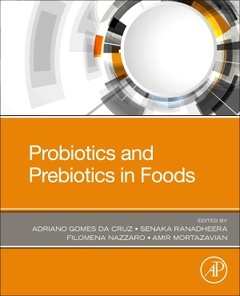Description
Probiotics and Prebiotics in Foods
Challenges, Innovations, and Advances
Authors: Gomes da Cruz Adriano, Ranadheera C. Senaka, Nazzaro Filomena, Mortazavian Amir
Language: English
Subjects for Probiotics and Prebiotics in Foods:
171.65 €
In Print (Delivery period: 14 days).
Add to cart346 p. · 19x23.3 cm · Paperback
Description
/li>Contents
/li>Readership
/li>Biography
/li>Comment
/li>
Probiotic and Prebiotics in Foods: Challenges, Innovations, and Advances reviews recent advances, innovations, and challenges in probiotics/prebiotics in food and beverages. The book presents up-to-date, novel and extensive information regarding recent research and applications in probiotics and prebiotics in food. Sections address probiotics, prebiotics, paraprobiotics and postbiotics, probiotics, prebiotics and bucal health, probiotics, prebiotics and obesity, probiotics, prebiotics and sleep quality, in vitro and in vivo assays for selection of probiotics, probiotics and mycotoxins, edible films added to probiotic and prebiotics, predictive microbiology applied to development of probiotic foods, non-bovine milk products as probiotic and prebiotic foods, emerging technologies, and much more.
Written for food scientists, nutritionists, health professionals, food product developers, microbiologists, those working in food safety, and graduate students and researchers working in academia, this book is a welcomed resource on the topics discussed.
1. The biotics family
2. Emerging Prebiotics
3. Probiotics and Prebiotics in Renal diseases
4. Probiotics in Oral Health
5. Multistrain Probiotics and Benefits for the Consumer´s Health
6. Milk Quality for Development of Probiotic and Prebiotic Dairy Foods
7. No-bovine Milk Products as Probiotic and Prebiotic Foods
8. Fermented milk: the most famous probiotic, prebiotic and symbiotic food carrier
9. Probiotic and Prebiotic Plant-milk Foods
10. Beer with Prebiotics and Probiotics
11. Cereals Bars with Added Probiotics and Prebiotics
12. Fruit Juices with Added Prebiotics and Probiotics
13. Probiotics and Prebiotics in Animal Feed
14. Probiotics and Prebiotics in Fish Aquaculture
15. Electric technologies applied to probiotic and prebiotic food
16. Ultrasound Applied to Prebiotic and Probiotic Foods
17. Probiotics and Mycotoxins
C. Senaka Ranadheera is an academic at the University of Melbourne, Australia. Dr. Ranadheera is completing research on probiotic technology and food quality, microbiology, and safety and completed his PhD on probiotic applications in dairy foods in 2012.
Filomena Nazzaro is senior scientist at the Institute of Food Science, of CNR (CNR-ISA) in Avellino, Italy, where she is also head of the Laboratory of Food Safety and Biotechnology. Dr. Nazzaro’s research is divided among biochemical and biological characterization of vegetables, the study of probiotics and prebiotics, with the application of technologies, such as microencapsulation, to formulate new functional foods. In addition, she studies the antimicrobial activity and quorum quenching by polyphenols/dairy peptides.
Amir Mortazavian is Professor of Dairy Science and Technology in Shahid Beheshti University of Medical Sciences where he researches the development of probiotics and prebiotics dairy foods, with the application of technologies, such as microencapsulation.
- Includes coverage of both dairy and non-dairy probiotics, prebiotics and symbiotic food products
- Discusses the efficacy of food substrate in probiotic and prebiotic delivery
- Presents predictive microbiology models




